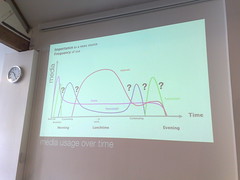MEX: The Delicate Path of Balancing Commercial Imperative and User Experience, Priya Prakash
MEX: The Delicate Path of Balancing Commercial Imperative and User Experience, Priya Prakash
Priya's moved from Flirtomatic to Icon to Nokia.
Balancing commercial imperatives with user experience is a bit like "Man on Wire": it's tough but if you do it right, there's a beauty to it.
What is value, as perceived by the customer?
References the $999 "I Am Rich" app. 3 days of fame on the app store led to $5300 dollars.
I hang out on customer forums when I don't have time to talk to real people: found someone wanted to transfer old text messages from an old iPhone to a new one. No matter how interesting the GUI is, there's sentimentality here.
Orange Wednesdays: long-running promotion, clearly defined benefits, touches on brand value (bringing people together to share an experience).
Shows iPhone, Prada Phone, Blackberry: each has a perceived value, different audience. Not everyone goes for the iPhone.
Traditionally marketing pushes for more functions, linking more functions to more value. But we know people use small %age of functions on phones.
Value is perceived based on the story you create in the mind of the customer.
Shows 2008 CRM planner for Flirtomatic. Every week Priya sat with her team to come up with new promotions and campaigns. Talks about leap year proposal day. Talks about flirt point currency, encouraging sleeping flirters to wake up.
 Can a paid-for service enhance the users' perception of the experience?
Can a paid-for service enhance the users' perception of the experience?
Where and when are value exchanges happening?
In Flirtomatic the biggest call to action was "I'm bored". Don't make registration a barrier to entry. What are the hooks motivating people to come back?
Compare to Sky+, radio, daily newspaper and Guardian web site. You can consume the same news through all of then. Radio feels free but is prepaid via license fee; web site is ad-funded; paper is paid-for and ad-funded; Sky+ shows it.
Shows graph of media consumption throughout the day. Shows graph of mobile vs PC usage of Flirtomatic per day.
Shows table-data-porn from Flirtomatic.
Talks about time spent running Digital Wellbeing at Bluebird: things need to change in retail world to keep folks engaged and involved.
Will distraction-based advertising ever work in mobile?
There is little value in it unless you're stationary.
Flirtomatic had more revenue from user-to-user ads than third party ads. There's a bidding process for ads, they're time-limited... a bit like advertorial.
What revenue models provide the best experience?
Skype credit automatically recharges itself. There's no repeat-entry of credit card details. It's seamless. Maybe only 8% of the people are propping up the rest of it, that's fine.
Ars Technica article on the Zune Pass: it's costs $30,000 to fill an iPod, ZunePass is a subscription model for music.
Shows the Flrtomatic Freemium Funnel - taking users from registration to revenue-generating.
On iPhone, engagement for paid apps is more than for free apps.
The App Store needs curation to help people discover apps, just like physical shops do.
What is customer reality?
People snack.
People never upgrade unless the free version doesn't deliver core benefits.
People don't register.
People use other peoples accounts.
People hesitate to give CC details on per-use basis.
People like frivolity.
People are bored or busy.
So to monitise, you need a highly reactive business strategy. It's like the fashion industry - look at Zara - you need to be flexible and timely to react to market needs.
Q: Re phones baffling users: one related article said that smartphones are driving the mobile market. If more people are buying them but everyone is saying they're confusing... where's the disconnect?
A: People want them, but can't use them.
Q: Industry has thought of functions as physical things for too long. We've spent a lot of time building swiss army knives and albatrosses.
A: There's been an underappreciation for frivolity too. It's not a question of more functions being bad, it's about communicating value to users and looking at the discovery process.